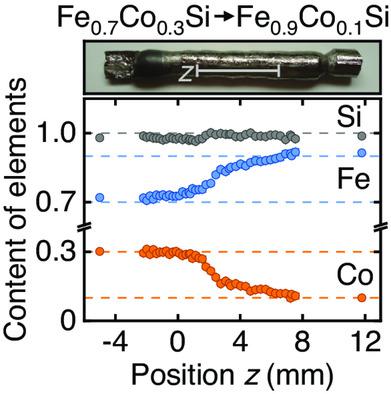当前位置:
X-MOL 学术
›
Phys. Status Solidi B
›
论文详情
Our official English website, www.x-mol.net, welcomes your feedback! (Note: you will need to create a separate account there.)
Compositional Studies of Metals with Complex Order by means of the Optical Floating-Zone Technique
Physica Status Solidi (B) - Basic Solid State Physics ( IF 1.6 ) Pub Date : 2021-09-22 , DOI: 10.1002/pssb.202100159 Andreas Bauer 1 , Georg Benka 1 , Andreas Neubauer 1 , Alexander Regnat 1 , Alexander Engelhardt 1 , Christoph Resch 1 , Sabine Wurmehl 2 , Christian G. F. Blum 2 , Tim Adams 1 , Alfonso Chacon 1 , Rainer Jungwirth 3 , Robert Georgii 1, 3 , Anatoliy Senyshyn 3 , Björn Pedersen 3 , Martin Meven 4, 5 , Christian Pfleiderer 1, 6, 7
Physica Status Solidi (B) - Basic Solid State Physics ( IF 1.6 ) Pub Date : 2021-09-22 , DOI: 10.1002/pssb.202100159 Andreas Bauer 1 , Georg Benka 1 , Andreas Neubauer 1 , Alexander Regnat 1 , Alexander Engelhardt 1 , Christoph Resch 1 , Sabine Wurmehl 2 , Christian G. F. Blum 2 , Tim Adams 1 , Alfonso Chacon 1 , Rainer Jungwirth 3 , Robert Georgii 1, 3 , Anatoliy Senyshyn 3 , Björn Pedersen 3 , Martin Meven 4, 5 , Christian Pfleiderer 1, 6, 7
Affiliation

|
The availability of large high-quality single crystals is an important prerequisite for many studies in solid-state research. The optical floating-zone technique is an elegant method to grow such crystals, offering potential to prepare samples that may be hardly accessible with other techniques. As elaborated in this report, examples include single crystals with intentional compositional gradients, deliberate off-stoichiometry, or complex metallurgy. For the cubic chiral magnets Mn1–xFexSi and Fe1–xCoxSi, single crystals are prepared in which the composition is varied during growth from x = 0 to 0.15 and from x = 0.1 to 0.3, respectively. Such samples allow us to efficiently study the evolution of the magnetic properties as a function of composition, as demonstrated by means of neutron scattering. For the archetypical chiral magnet MnSi and the itinerant antiferromagnet CrB2, single crystals with varying initial manganese (0.99–1.04) and boron (1.95–2.1) content are grown. Measurements of the low-temperature properties address the correlation between magnetic transition temperature and sample quality. Furthermore, single crystals of the diborides ErB2, MnB2, and VB2 are prepared. In addition to high vapor pressures, these materials suffer from peritectic formation, potential decomposition, and high melting temperature, respectively.
中文翻译:

用光学浮区技术研究复杂有序金属的成分
大型高质量单晶的可用性是固态研究中许多研究的重要先决条件。光学浮动区技术是一种生长此类晶体的优雅方法,它提供了制备其他技术可能难以获得的样品的潜力。如本报告所述,示例包括具有有意成分梯度的单晶、故意偏离化学计量或复杂冶金。对于立方手性磁体 Mn 1– x Fe x Si 和 Fe 1– x Co x Si,制备了单晶,其中组成在生长过程中从x = 0 到 0.15 以及从x = 0.1 至 0.3,分别。这些样品使我们能够有效地研究磁性随成分的变化,如中子散射所证明的那样。对于原型手性磁体 MnSi 和流动反铁磁体 CrB 2,生长具有不同初始锰(0.99-1.04)和硼(1.95-2.1)含量的单晶。低温特性的测量解决了磁转变温度和样品质量之间的相关性。此外,制备二硼化物ErB 2、MnB 2和VB 2的单晶。除了高蒸气压外,这些材料还分别遭受包晶形成、潜在分解和高熔化温度的影响。
更新日期:2021-09-22
中文翻译:

用光学浮区技术研究复杂有序金属的成分
大型高质量单晶的可用性是固态研究中许多研究的重要先决条件。光学浮动区技术是一种生长此类晶体的优雅方法,它提供了制备其他技术可能难以获得的样品的潜力。如本报告所述,示例包括具有有意成分梯度的单晶、故意偏离化学计量或复杂冶金。对于立方手性磁体 Mn 1– x Fe x Si 和 Fe 1– x Co x Si,制备了单晶,其中组成在生长过程中从x = 0 到 0.15 以及从x = 0.1 至 0.3,分别。这些样品使我们能够有效地研究磁性随成分的变化,如中子散射所证明的那样。对于原型手性磁体 MnSi 和流动反铁磁体 CrB 2,生长具有不同初始锰(0.99-1.04)和硼(1.95-2.1)含量的单晶。低温特性的测量解决了磁转变温度和样品质量之间的相关性。此外,制备二硼化物ErB 2、MnB 2和VB 2的单晶。除了高蒸气压外,这些材料还分别遭受包晶形成、潜在分解和高熔化温度的影响。



























 京公网安备 11010802027423号
京公网安备 11010802027423号